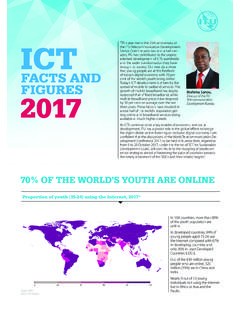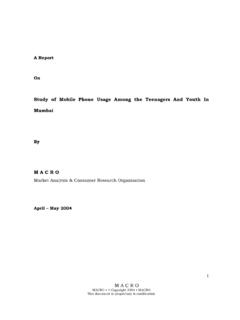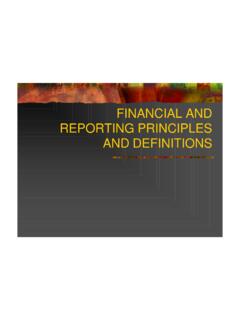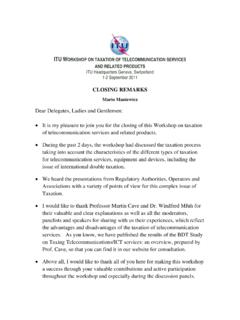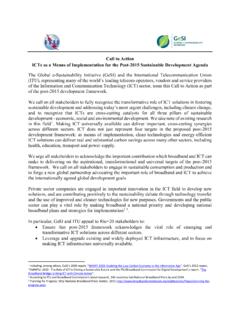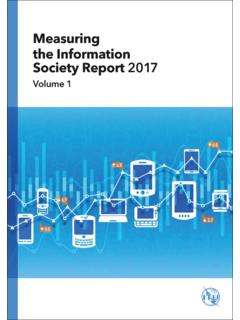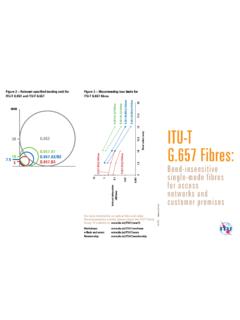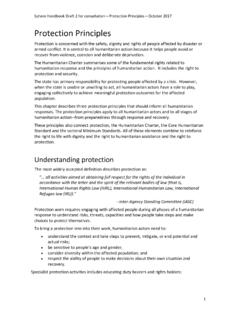Transcription of Overview of disaster management and vulnerability - Civil ...
1 Overview of disaster Risk management and VulnerabilityLameck BeteraDepartment of Civil Protection 12/15/20112 Introduction Zimbabwe is among other countries in the SADC regionand the world at large that is vulnerable to a number ofhazards both natural and man-made, Due to increased volumes of traffic , coupled with theraged terrain in some parts of the country and narrowroads, the country has lost a number of lives andproperty due to road traffic accidents, The recent years have seen a number of people beingleft homeless and infrastructural damages due to adramatic increase in severe climatic andweatherconditions caused by climate change, Hydro-meteorological disasters such as cyclones,droughts and floods have had direct impact on the poor,incapacitated and marginalised communities of thecountry12/15/20113 Institutional arrangements In Zimbabwe, government commitment in themanagement of disasters is demonstrated by theexistence of the legal enabling statutes, whichcreate the conducive environment for disasterrisk reduction initiatives.
2 The Government of Zimbabwe committed itselfin setting up institutional framework andappropriate policies for disaster Risk management POLICY STATEMENT IN ZIMBABWEB road Policy Statement National Policy for Civil Protection states that Every Citizen of Zimbabwe should assist where possible to avert or limit the effects of a disaster . Central Government initiates disaster preparedness programmes through the relevant sector ministries with local administration taking the responsibilities for implementing and maintaining its effectiveness. Sector Specific Policies12/15/20115 LEGISLATIONO verall coordination. The Minister responsible for Local Government Rural and Urban Development is charged with the coordinative role as empowered by the Civil Protection Act No. 5 of 1989. The Act provides for:- Special powers designed to establish, coordinate and direct the activities of both the public and private emergency services Guidelines for action and maximum use of resources since disaster mitigation requires a multisectoral and interdisciplinary approach; The establishment of a National Civil Protection Fund The fund is applied to the development and promotion of Civil Protection activities throughout the country.
3 Commandeering of resources for the purpose of mitigating a disaster , Declaration of the state of disaster by the president of Zimbabwe12/15/2011612/15/20117 The Structure of the Civil Protection System in ZimbabwePresident (Head of State)Parliament (Legislative)Cabinet (Policy formulation)1 2 3 4 5 6 7 8 9 ,R Sister Ministries/ Departments/ UN, NGO, Red C&UD Parastatals Representatives NB: Other members are co opted as and when Protection Organisation in ZimbabweCO-ORDINATORCO-ORDINATOR/PLANNIN G COMMITTEEN Minister LGR&UDNational Civil Protection A+Committee (NCPC)T Civil Protection Directoratewith a Multisectoral RepresentationISecretariatP Provincial AdministratorProvincial Civil ProtectionR MLR&UDCommittee (PCPC)O with a Multisectoral RepresentationVD District AdministratorDistrict Civil ProtectionI(MLR&UD)S Committee (DCPC)
4 Twith a Multisectoral Representation12/15/20119 Levels of Emergency Preparedness Planning in ZimbabweNational Civil Protection PlanNational Civil Protection PlanProvincial Civil Protection PlansProvincial Civil Protection PlansDistrict Civil Protection PlansDistrict Civil Protection PlansSectoral / institutional PlansSectoral / institutional PlansWard level Civil Protection plansCommunity based DRR Draft bill for amending the Civil Protection Act (1989) was developed. Draft policy framework for mainstreaming disaster risk reduction in development planning was also developed. The drafts are in conformity with International standards, Hyogo Framework of Action (HFA)12/15/201111 POLICY & LEGISLATION REVIEWH yogo Framework Derived from the Yokohama Strategy and seeks to: Ensure that disaster risk reduction is a national and local priority with a strong institutional basis for implementation Identify, assess and monitor disaster risks and enhance early warning Use knowledge, innovation and education to build a culture of safety and resilience at all levels Reduce underlying risk actors Strengthen disaster preparedness for effective response at all levelsDisaster risk reduction framework Sustainable development underscores risk reduction initiatives Risk assessment is critical in determining the requisite institutional arrangements and capacities to reduce risk Research and sharing of information are key in reducing risk Application of risk reduction measures through prevention, mitigation and preparedness must be integrated at all levels national.
5 Sub national and community levels Sustainability must seek to address large scale disaster events in much the same way as common small scale eventsDISASTER RISK PROFILE AND VULNERABILITIES12/15/201114 Hazard and vulnerability A hazardis potentially damaging physical event, phenomenon or human activity that could cause loss of life or injury, property or environmental damage. vulnerability - The conditions determined by physical, social, economic, environmental factors which increase susceptibility of a community to the impact of hazards. vulnerability factors are characteristics of the environment, individual and society. 12/15/201115 vulnerability cont Conditions which increase susceptibility of a community to the adverse impact of hazards. These are: Physical Social Economic Environmental/ecological Cultural/religious Political/ideological Technological Educational Institutional/organizationalCapacity Combination of strengths, resources, skills, or knowledge available within an individual, community, society, organization or country to reduce illness, disability or death from hazards and promoting health, safety and security Droughts Agriculture is a vulnerable sector in terms of climate related hazards.
6 This is exacerbated by the country s strong dependency on rain fed agriculture The ability to forecast drought occurrence will help to protect the agricultural economy and ensure reliable production by facilitating the use of appropriate adaptation and mitigation Periodic droughts have a significant impact on crops, livestock and livelihoods of communities and the nation at large. Droughts can also be nation wide disaster eg, 1982/83, 1991/92. More extreme in ecological regions 4 and 512/15/201120 Ecological zonesAreas which are usually termed drought prone areas are found in regions IV and V (colored). ( Climate handbook of Zimbabwe)Ten driest rainfall seasons - ZimbabweSeasonTotal Seasonal RainfallPercentage of Normal,1991 warning systems are in place; Met Office, NEWU, FEWSNET and Drought Monitoring Centre (DMC)AGRITEX and Cooperating partners (Mitigation Methods) FAO, NGOs Drought resistant crops Grazing schemes Drought relief programmes Irrigation Water harvesting Moisture conservation measuresTropical CyclonesVulnerability These cyclones enter Zimbabwe mainly through the South- Eastern and to a lesser extend the North Eastern part of the country as shown on the map.
7 They cause a lot of damage to people s livelihoods and infrastructure. They are more prevalent in the month of February in Zimbabwe.(MET OFFICE)Capacity The existence of an early warning mechanism involving the Meteorological Services Department and the Civil Protection organisation in Zimbabwe,FLOODS12/15/201127 Flood Prone Areas in ZimbabweVulnerability In Zimbabwe, societal vulnerability is a function of location of communities in relation to river systems, terrain configuration and type of building structures, Middle Sabi, Muzarabani. Tsholotsho Mushumbi pools Chikwalakwala Tuli-Shashe Gokwe, Down stream of major, medium and small damsCapacity Capacity can be viewed as institutional capacity, policy capacity, community capacity, preparedness capacity (prevention, mitigation (anticipation, forecasting, monitoring)), response and rehabilitation or capacity Zimbabwe National Water Authority (ZINWA) Hydrological Section is one major partner in the flood early warning system in conjunction with the Meteorological Services Department and Civil Protection.
8 ZINWA monitors river flows in the whole country, and with the aid of MET forecasts, predict the state of hydrology, however real time data is still largely lacking. Regular awareness campaigns in flood prone areasCommunity capacity Local (affected) communities have an important role to play in flood mitigation, early warning and response . They are always the first to respond to disasters They use their coping strategies (Indigenous Knowledge Systems) as initial early and LightningHazardVulnerabilityCapacityLigh tningOf all the districts, Gutu, leads with approximately 10 fatalities per annumBinga, Marondera and Rusape follow a long way behind with 3 to 4 per rest have 1 to 2 casualties or fatalities per annumVery difficult to forecast exact areas which are going to be struckCan only give areas which are prone to lightning strikesCan advise on objects favoured by lightning strikesMitigationZESA, CPO can educate the communities on importance of installing lightning conductors Assessment: ZRP12/15/201134 Storms & Hailstorm damage Hailstorm damage Hundreds of hectors of tobacco and other crops are destroyed every year The biggest Southern African earthquake in decades struck the Save Valley in Mozambique on 23rd February 2007 at around 12:19am.
9 The earthquake measuring 7,5 on the Richter scale was centred on the north bank of the Save River, very close to a national park in a sparsely-settled area in Mozambique. 9 people were injured and property was damaged in some eastern parts of the country such as ChipingeDistrictEARTHQUAKESThe Eastern Highlands and Southern Mozambique are part of the tail end of the East African Great Rift Valley System. 12/15/201138 Damages caused by an Earthquakes in Chipinge (2007)EarthquakesHazardVulnerabilityCapa cityEarthquakesLake KaribaBoth natural and reservoir induced earthquakes occur. Many events are felt by the locals especially Valley and eastern borderMainly natural events associated with the east Africa rift system. Recently, rock bursts have been reported in the Penalonga area-indicative of mine induced eventsNyamandlovu Aquifer Since 1999 four events recorded (mag 25/6/04)MonitoringMonitoring of seismic activities in the country-Goetz ObservatoryAssessmentsCPOM itigationInfrastructure developmentCPOR egional collaborationData exchange with neighboursInternational collaborationTraining of HazardsHazardVulnerabilityCapacityTransp ortationPublicCommuters of public transport,Major transport routesEarly warning ZRP, Traffic Safety Council, TransportAssessment CPOM itigationCPO Education , abstinence from alcohol and drugs) Examination and treatment of drivers Environmental improvement (road condition, lighting, signs & markings)
10 Ecological modification Enforcement Emergency careTechnological hazards contHazardVulnerabilityCapacityChemical Spills/ Explosions/ toxic waste/Air/ land pollution/ mine collapse Industrial sites of Harare, Bulawayo, KweKwe, Norton, Gweru, Mutare, Masvingo and mining areas All major transportation routes and boarder areasEarly warning-Industry, ZRP, Local Authorities, Chief govt. mining engineer Assessments- NSSA-CPO-Chief govt. mining engineerMitigationNSSACPOM inesEnvironmental DegradationCommunal areas, and areas with sandy and alluvial soils such as Gokwe, or former gold rich warning-EMAA ssessments-EnvironmentMitigationEMA/AREX / Social Welfare/ UN agencies, NGOsCrowd Control problems / stampedesSporting EventsChurch gatheringsEarly warning-ZRPA ssessments-Emergency ServicesMitigation-CPOF iresForest Areas in the Eastern Highlands, road sides, along pathways, National Parks, Newly resettled areas, Domestic and IndustryEarly Warning-MET, general publicEMAA ssessmentsEmergency servicesMitigationCPO123456 ZAMBIABOTSWANASOUTH AFRICANAMIBIA123456 MOZAMBIQUEBIOLOGICAL HAZARDSM alariaCholeraTyphoidHIV/AIDSA nimal EpidemicsCrop PestsCHOLERAV ulnerability In the past it used to be common in areas with poor water & sanitation, temporary settlements and overcrowded slums.
